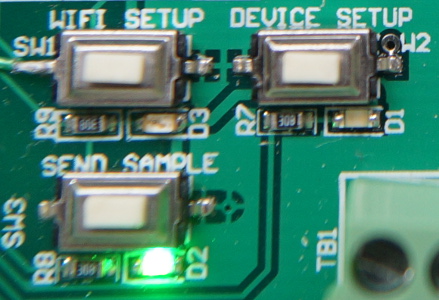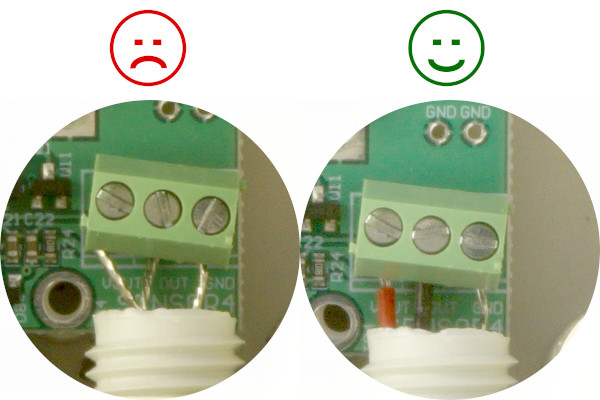VegeHub - Trouble Shooting Guide
Top 10 Reasons Your Hub isn't Working
- You're using the wrong network password. Make sure you are using the right password, and that the letter case is correct, and that you are logging into the correct network.
- Your batteries are dead. Make sure you are using new batteries, and that the voltage to the hub is at least 6V.
- The battery cable leads have come loose out of the terminal blocks. Tug on the cable to make sure it is secure. Make sure no wires are shorted or touching.
- The battery cable leads have the wrong polarity. The red wire should go to the V+ terminal, and the black to GND.
- You've pressed wrong setup button. Each button has a corresponding LED. When you are using your phone to select and setup the hub's WiFi credentials, make sure the red LED is lit. When you are trying to access the configuration pages on the hub make sure that the Yellow LED is lit.
- Your wifi network uses a captive portal. Many larger institutions such as universities use captival portal signs-ins to the internet. You can tell if it's capitive portal, if you are required to use a sign-in page before accessing the wifi network. The only way to get a VegeHub or other IOT device working with a captive portal is to bypass it, by using a secondary WIFI router connected to an ethernet port on the network.
- Your router's firewall is blocking the Hub. Log into your router, and make sure that the firewall isn't blocking hub trafic.
- Your USB drive is formatted with the wrong format. The drive must be formatted with FAT16 of FAT32. It will not work with Microsoft's latest abomination "FATeX"
- Your Hub is too far from your access point. During setup make sure that the hub is near the access point. Once it's working, then move it to the final location.
General Advice
When figuring out what could be wrong, you need to divide the problem to conquer it. Remove all sensors from the hub, so that you can rule out that the problem is with the sensors.
After the VegeHub has been configured to talk to a desired server, it will periodically contact the server, and send its data, according to it's sample rate. Whenever it sends an update, it will blink the green LED. If it is unable to connect to the server, or if there is some other problem, it will blink the red LED instead.

You should be able to see data on the server websites, as updates are sent.
When you are initially getting familiar with the VegeHub, set the sample and update periods to 1 minute intervals, for a high update rate, so that you can more quickly see if you are receiving data. Then, after you have everything working, set the sample and update periods to larger values to conserve battery power.
Make sure you trim any wires going to the terminal blocks, so that they are fully covered with insulation, as shown in the diagram below. If you don't trim the wires, they could short together if the wire is twisted at all.

Make sure your router is not blocking the VegeHub with any firewalls, and that the network doesn't have a captive portal.
Your router maintains a list of devices that its connected to with their IP addresses. You should see the vegehub in this list along with it's IP address.
Insert a thumb drive while you are going through the setup process. Any errors are written to a log file on the disk, so look at this file and it will give you some clues as to what is wrong.
Symptoms with Solutions
- Can not connect a laptop or phone to the Hub as a WIFI hotspot. Make sure that the red LED is lit. It should be the only LED lit. If all 3 LEDs are lit then most likely you have a bad battery. Use a voltmeter to test the battery voltage and make sure that the voltage is above 6V. If your network is a University network, make sure it doesn't use a captive portal sign-in.
- Can not bring up the setup pages on the hub. Make sure that the yellow LED is lit, and is the only LED that is lit. Make sure you have the right IP address for the hub, as these can change over type because your router reassigns them. Make sure that you have any firewalls turned off that might be blocking it.
- I've set up my own private web server on a Raspberry PI, but the hub is not posting data to it. Many computers have built in firewalls. Make sure you have allowed access to your web server, and it's port.
- I insert the USB drive, and can see the drive leds flash, but no files are written. The drive must be formatted with FAT16 of FAT32. Reformat your USB drive, or use a different drive with the correct format. Some newer and larger drives use FATeX, which will not work. Wait at least 10 seconds before removing the drive, to give it time to write.
- My batteries are dead after a few days. Make sure that the USB drive and adapter is removed. Also make sure that the board is set to "Battery Powered Mode" not "Power Adapter Mode"
- When my WiFi/Internet goes down for a while, my hub doesn't reconnect when it comes back up.
If your hub can not connect to the server because WiFi/Internet is not working, the hub will back off and not connect for a time period, that doubles each time. For example, if it fails to connect it will retry after 10 minutes. If it fails again, it will try after 20 minutes. If it fails again it will try after 40 minutes. If it fails again it will try again after 80 minutes, and so on. It will increase the retry period up to a maximum time of 24 hours. So if your internet is down for a long period of time, the hub will not try to connect for a long time. It does this to preserve battery power. If it kept retrying every five minutes, if your Internet was down for several hours it would drain the battery.
The solution is to just wait and be patient,and your hub will respond again within 24 hours or sooner. If you have unreliable internet or WiFi, then you should consider getting a better WiFi/internet solution.
VegeHub WiFi Sensor Hub -Diagnostic Lights
- Upon Power Up All 3 LEDs are lit. Most likely the battery has too low a voltage and needs to be replaced.
- Red LED is blinking Failure to connect to the WIFI network.
- Green LED is blinking Failure to connect to the server. Could be that you have bad SSL certificates, and need to update them.
- Yellow LED is blinking Failure to get the Internet time. It could be that the NIST timeservers are down.
Rare Issues
If you have more than one router on the network, make sure that they two router's DHCP have not fallen out of sync.
Diagnostic LEDs
There are three LEDs on the VegeHub/VegeSprinkler, These will turn on or blink in combinations, depending upon the state, or error code of the hub. To view their meaning see the Diagnostic LED Guide.